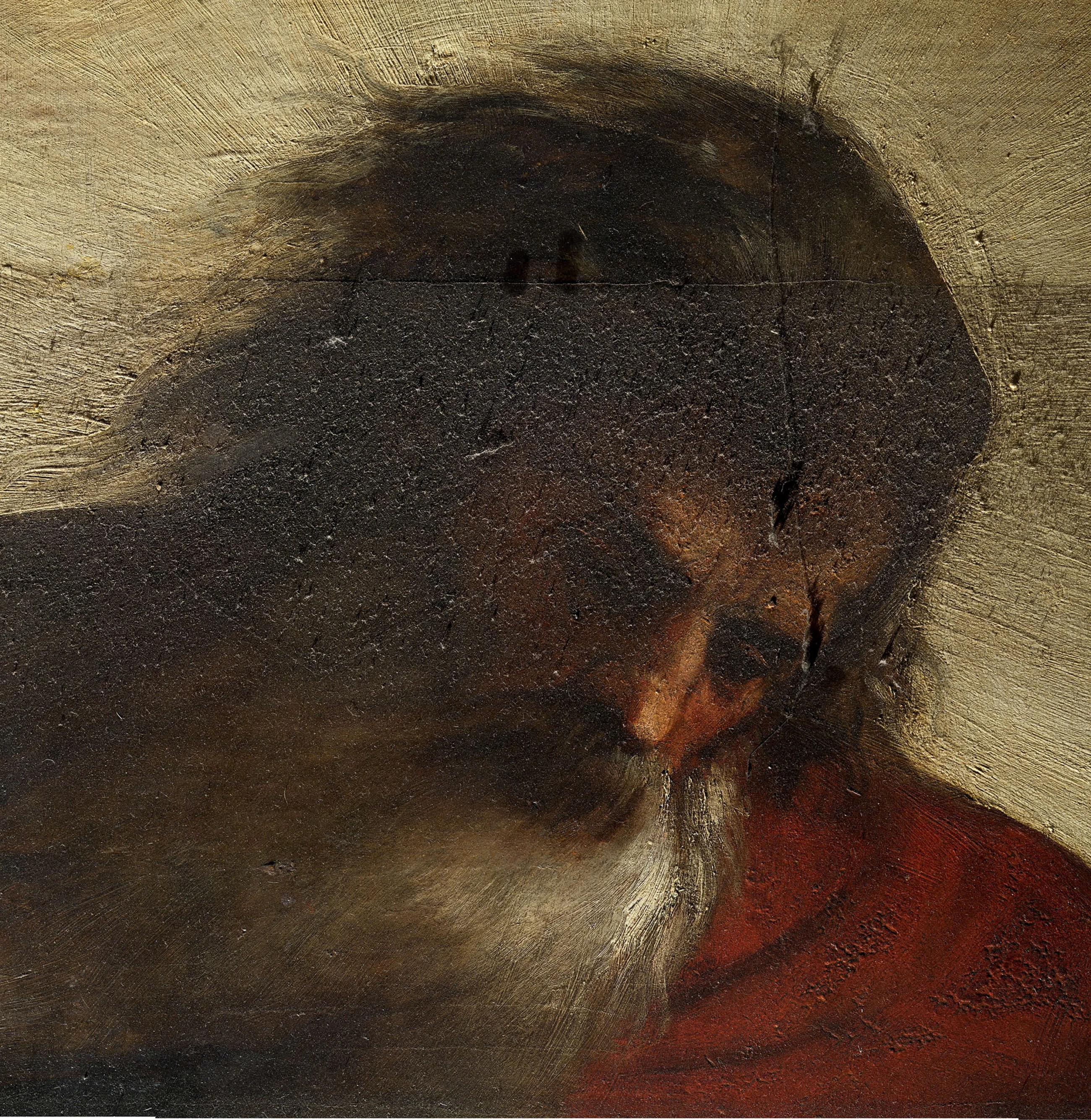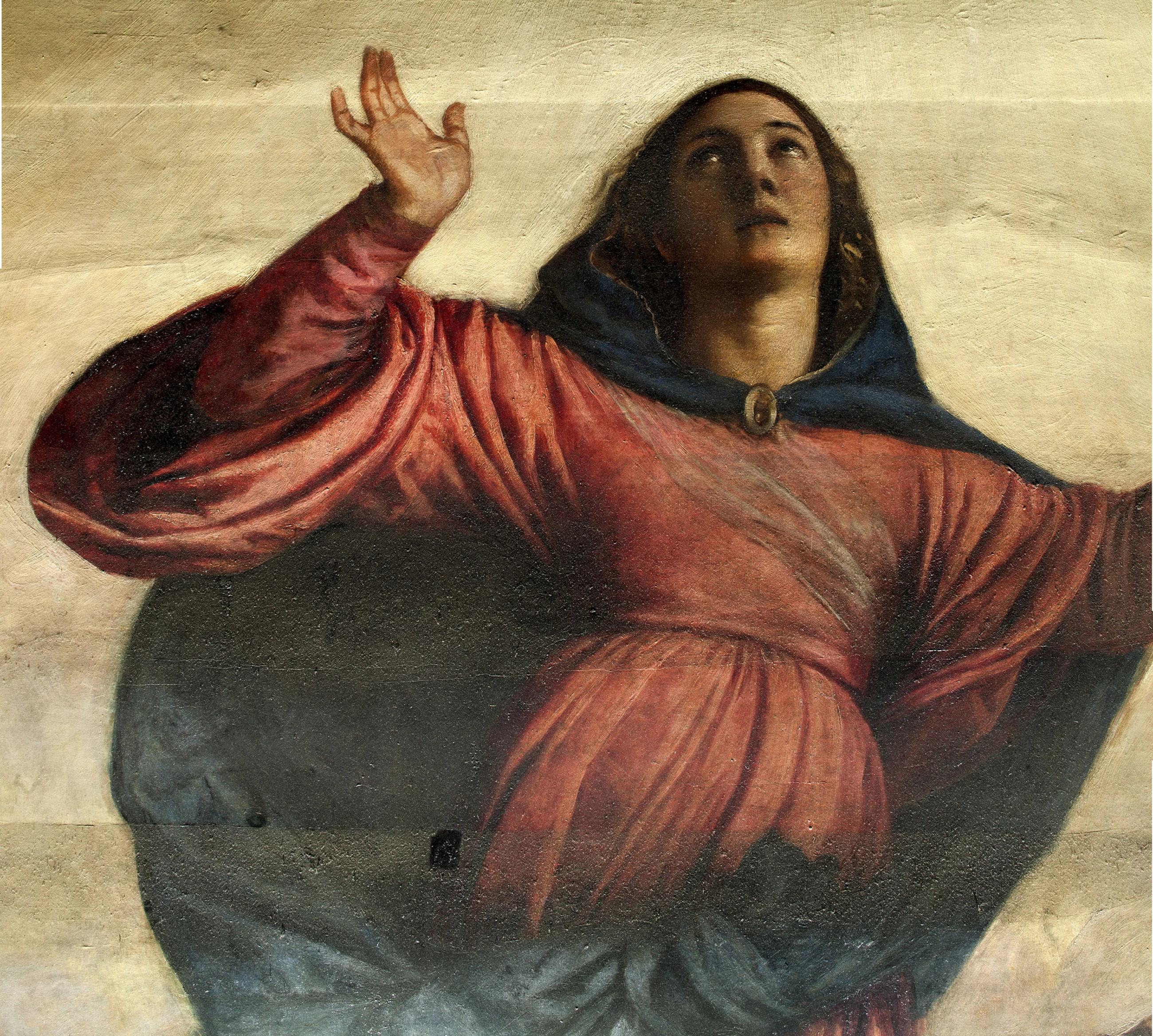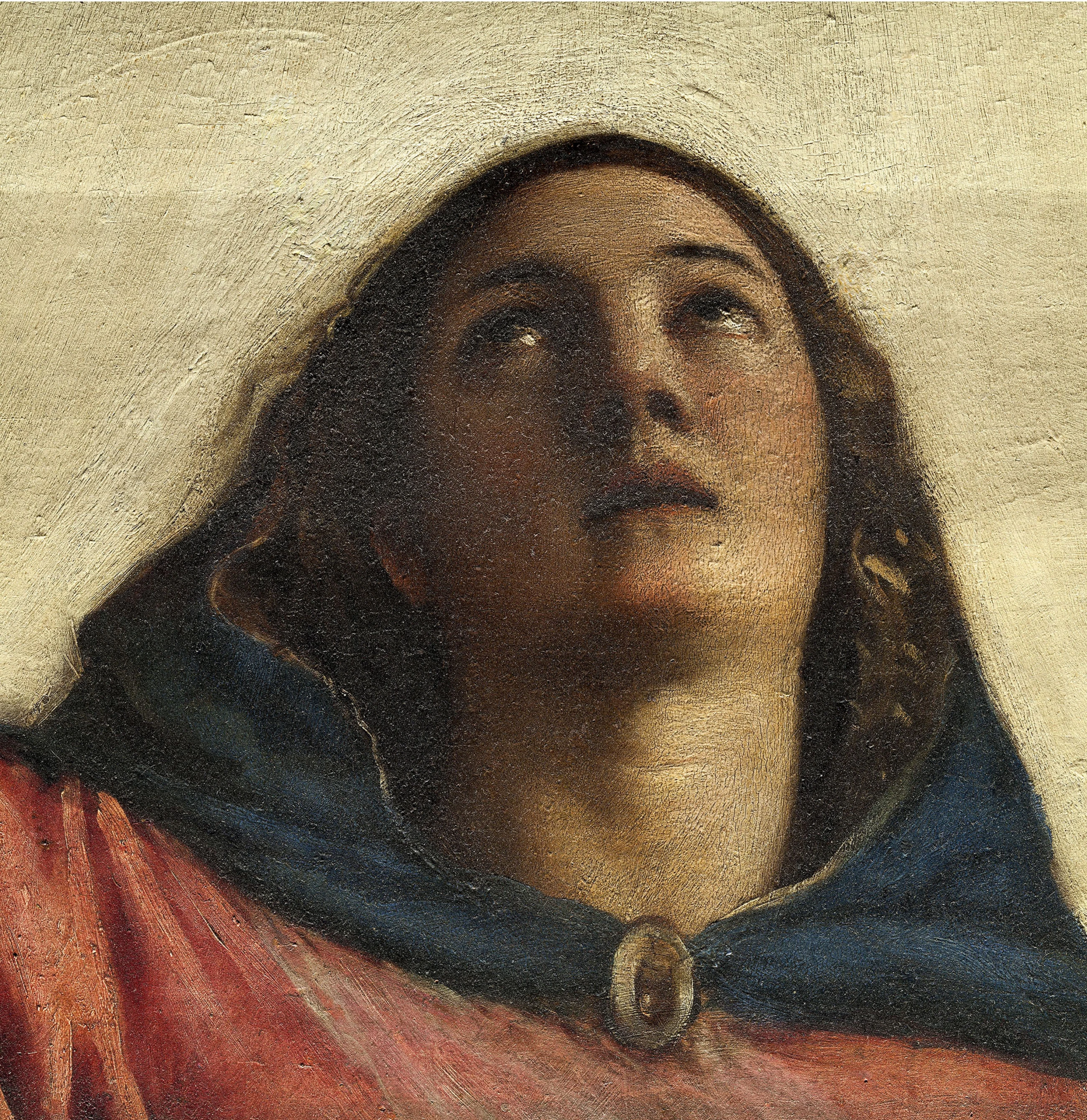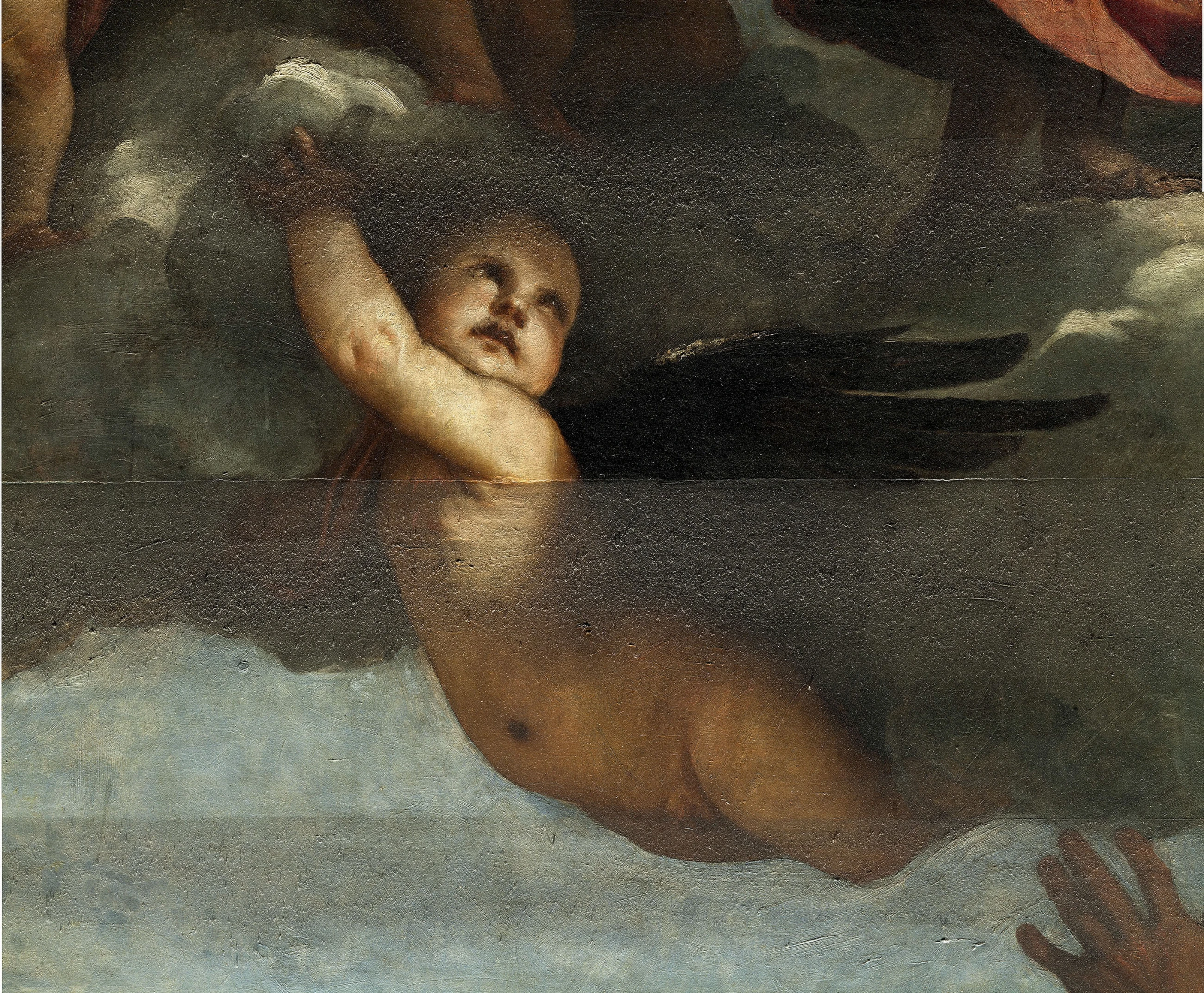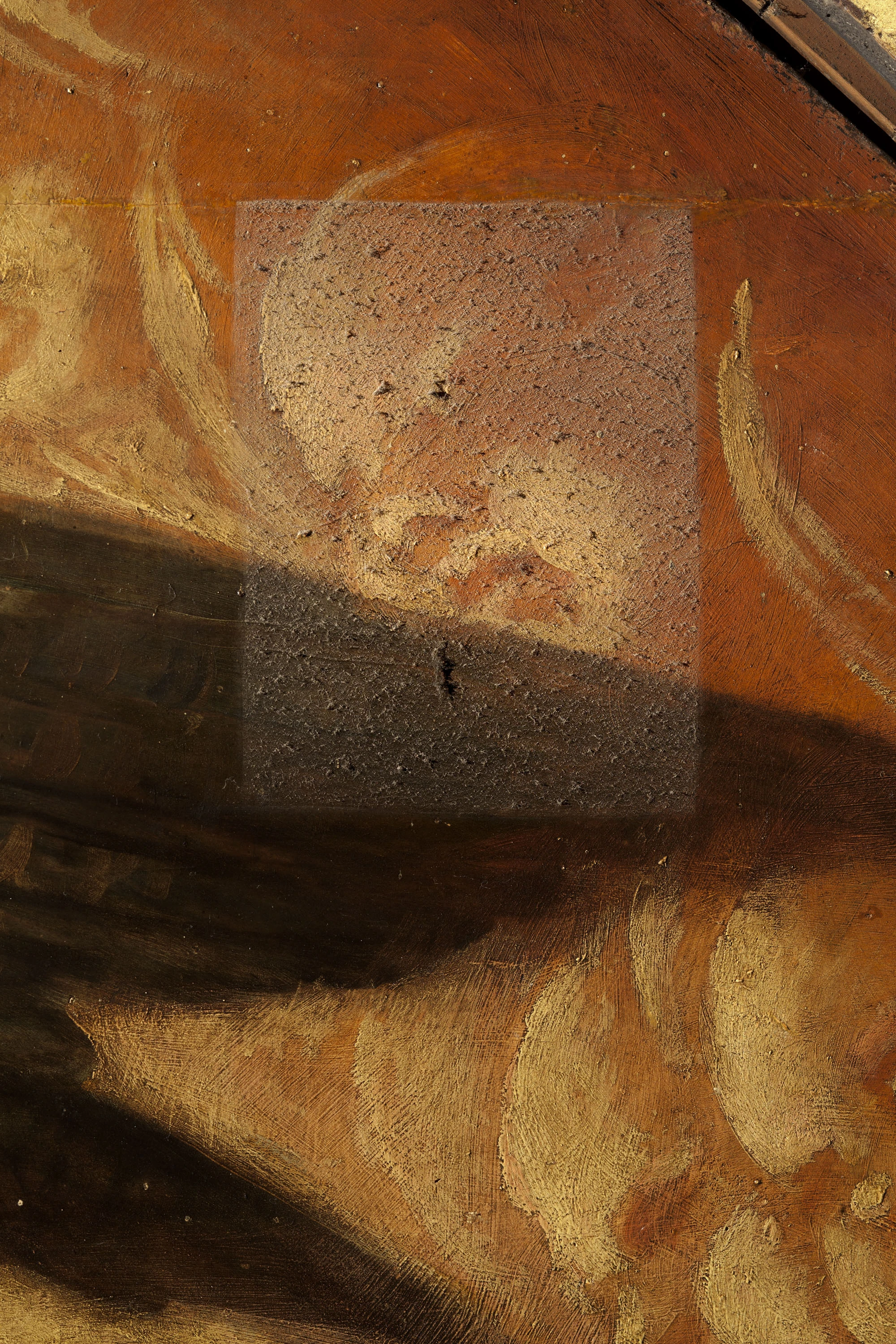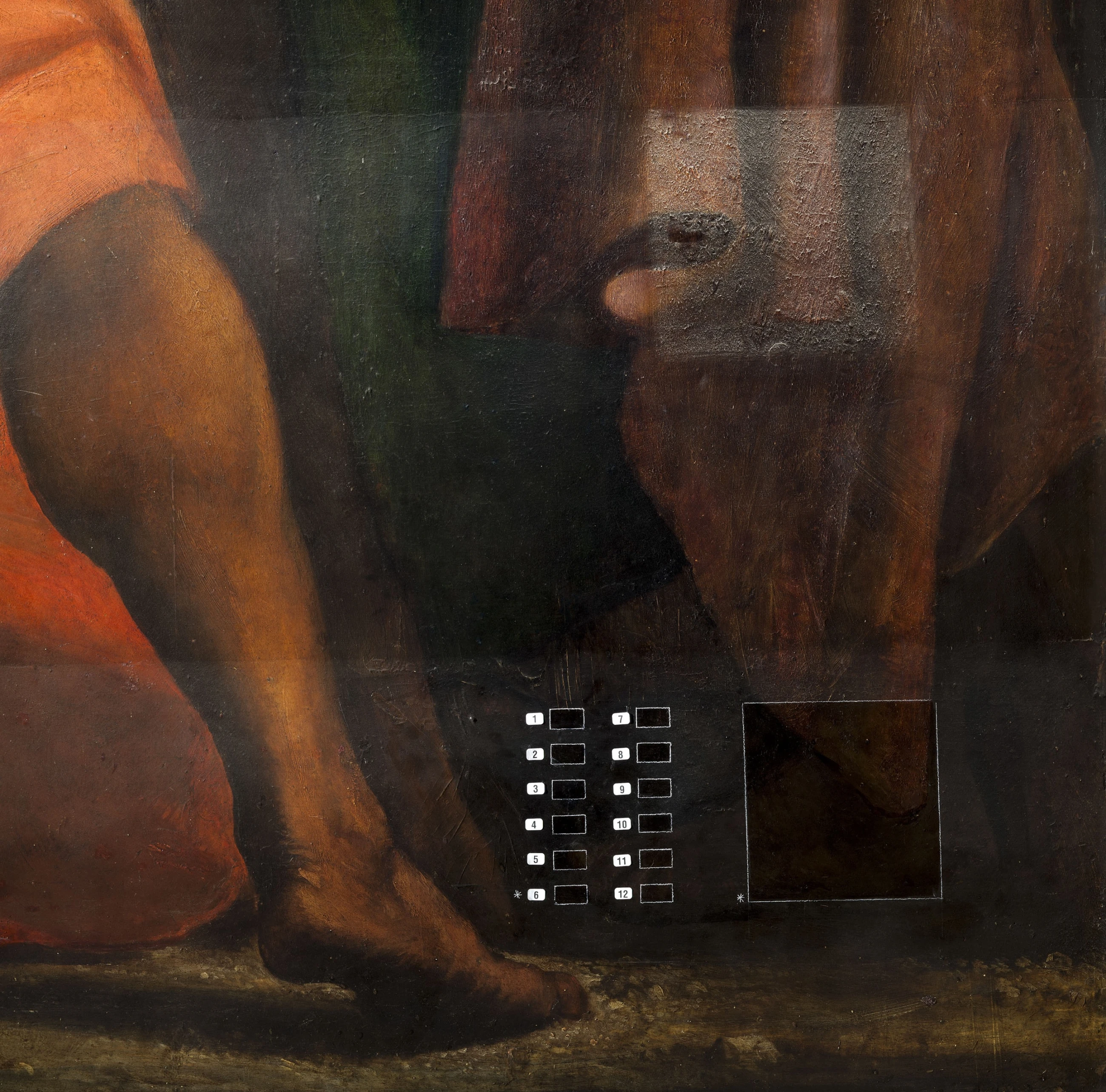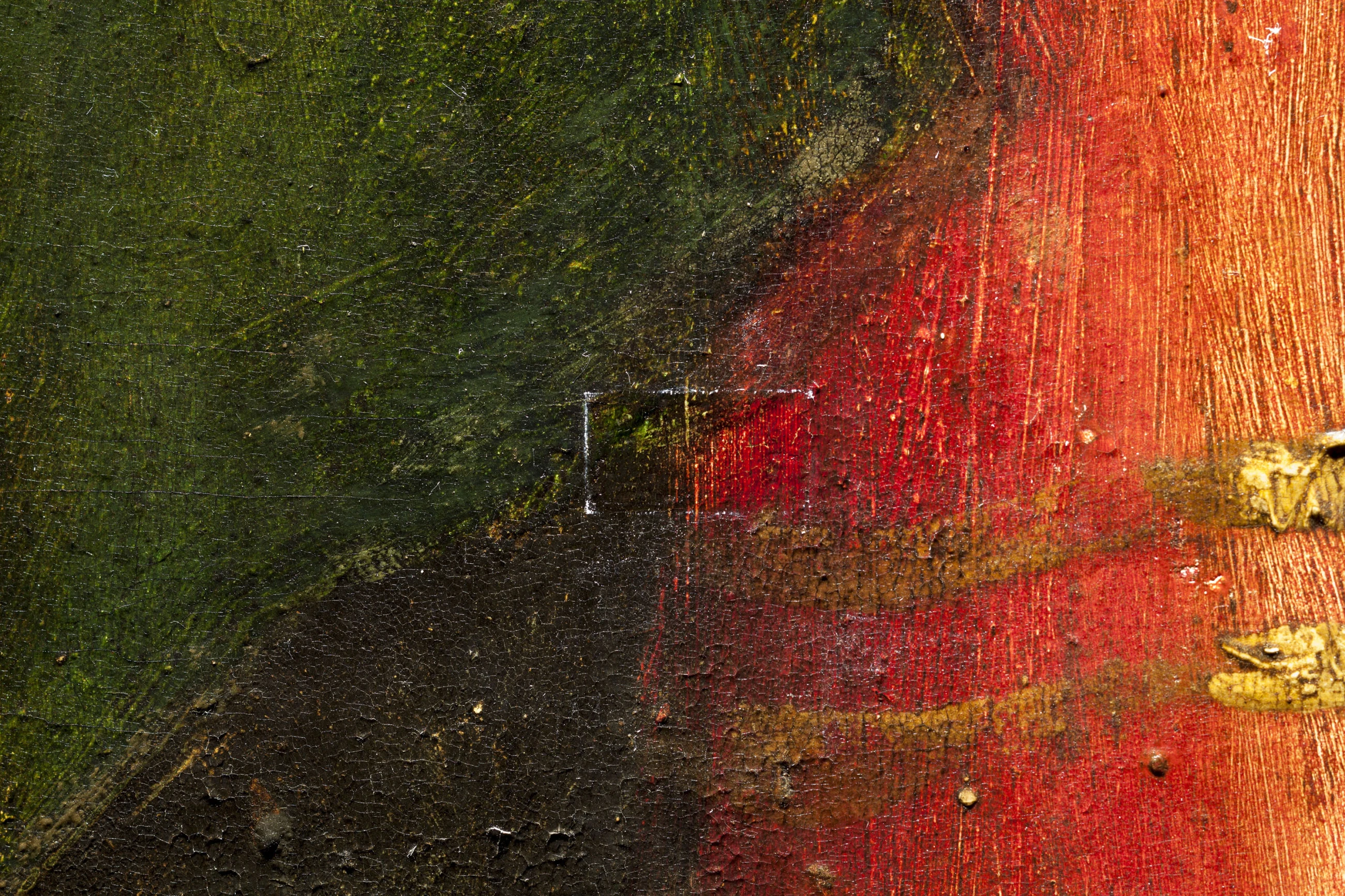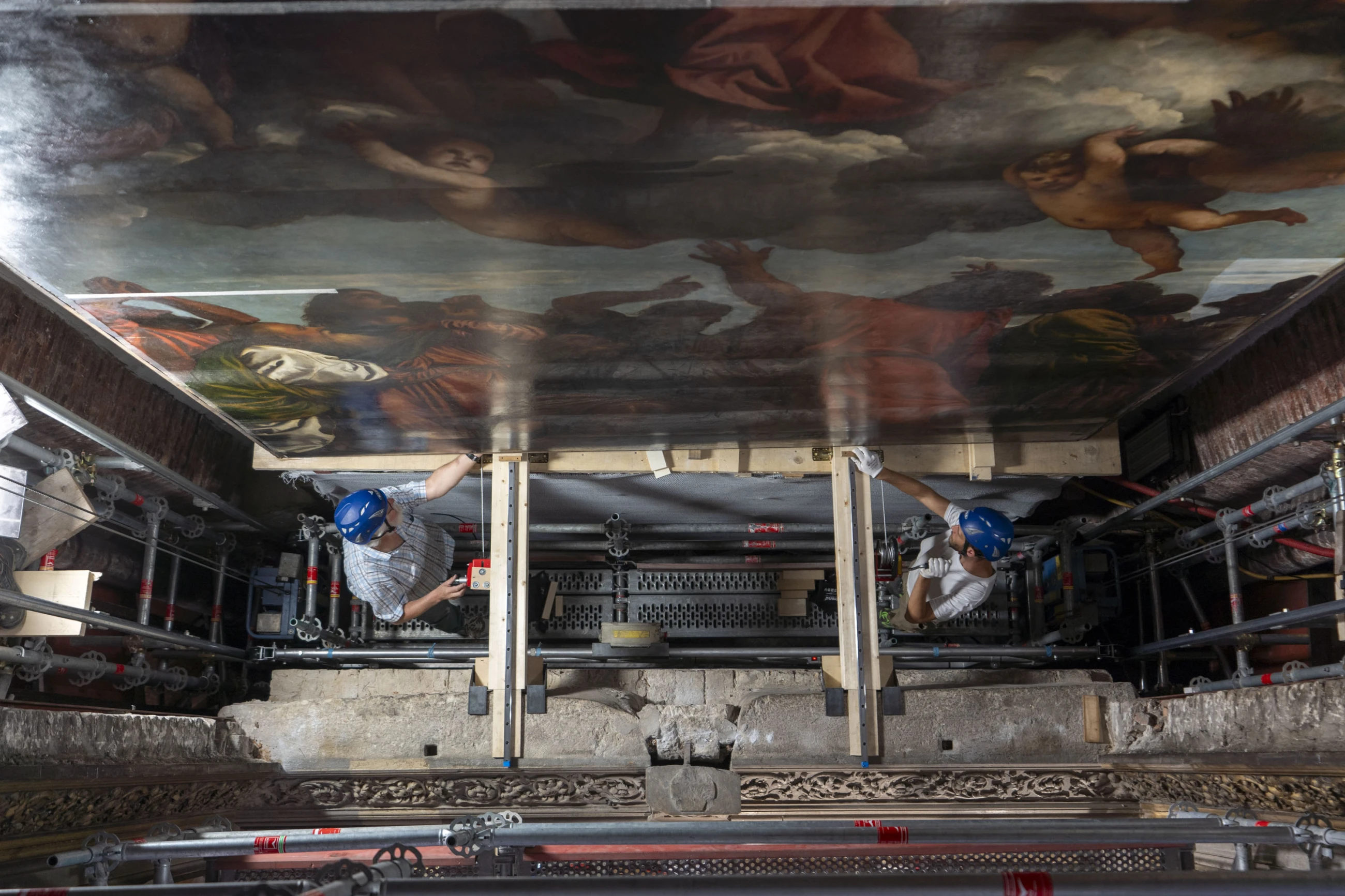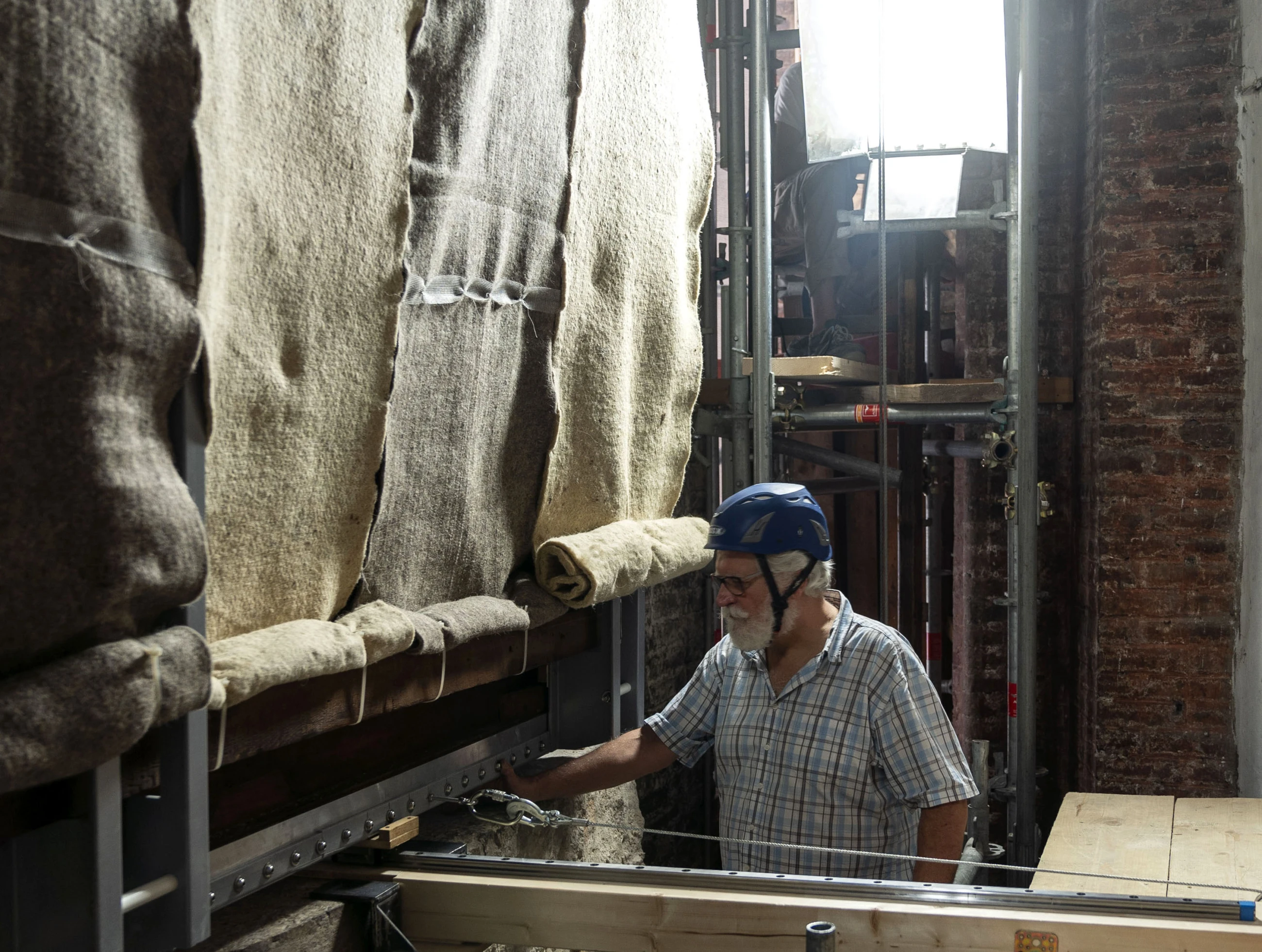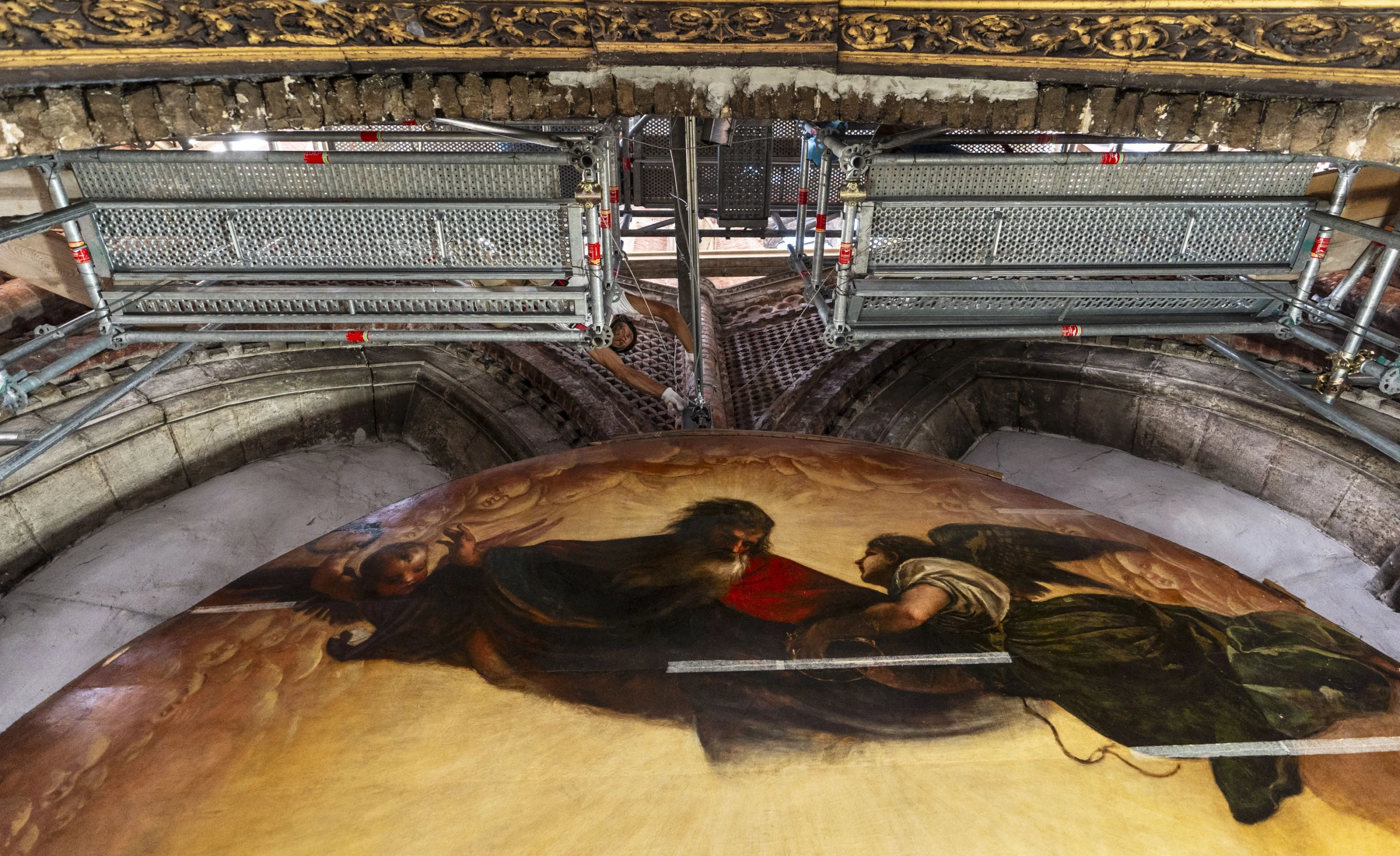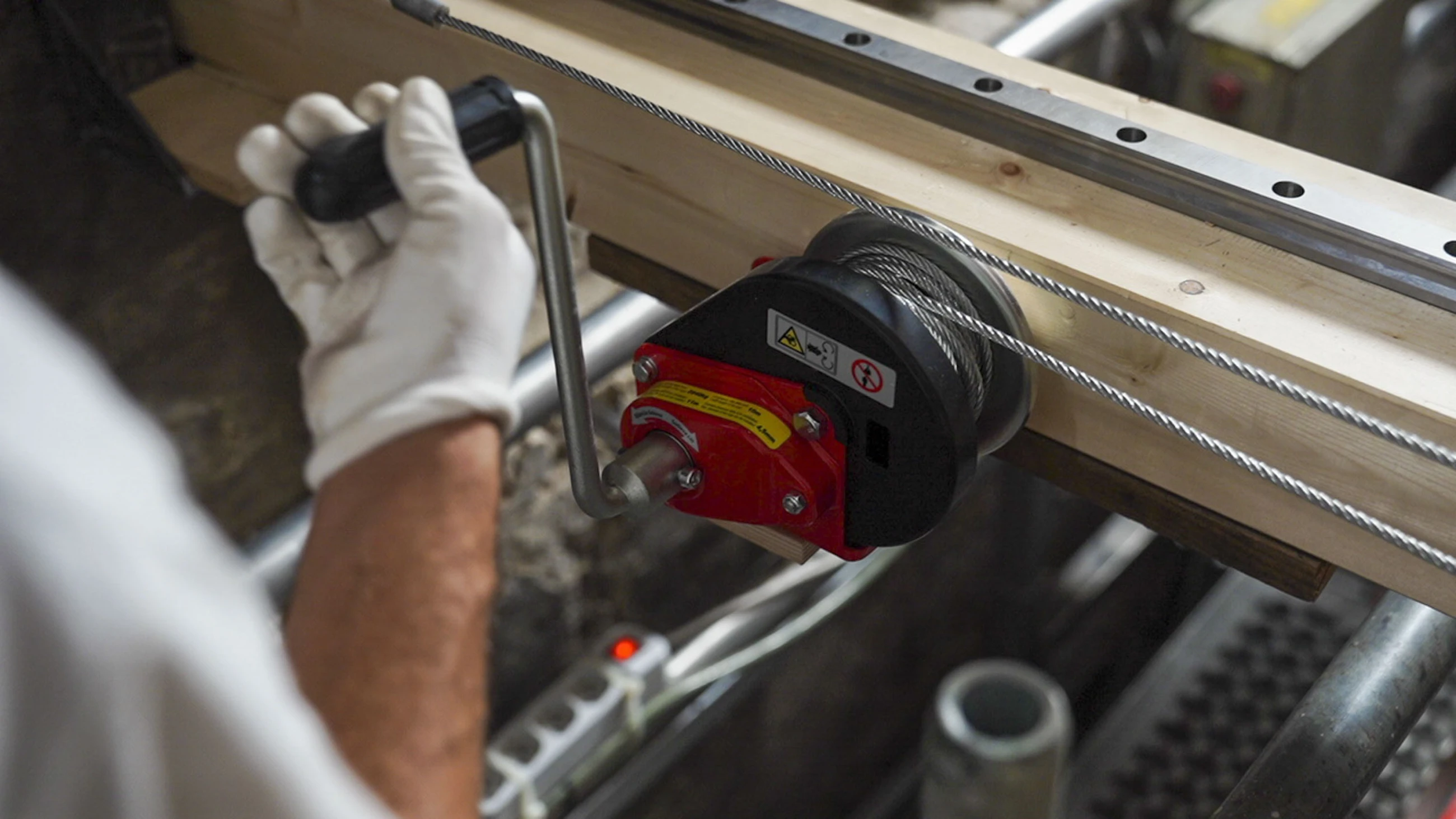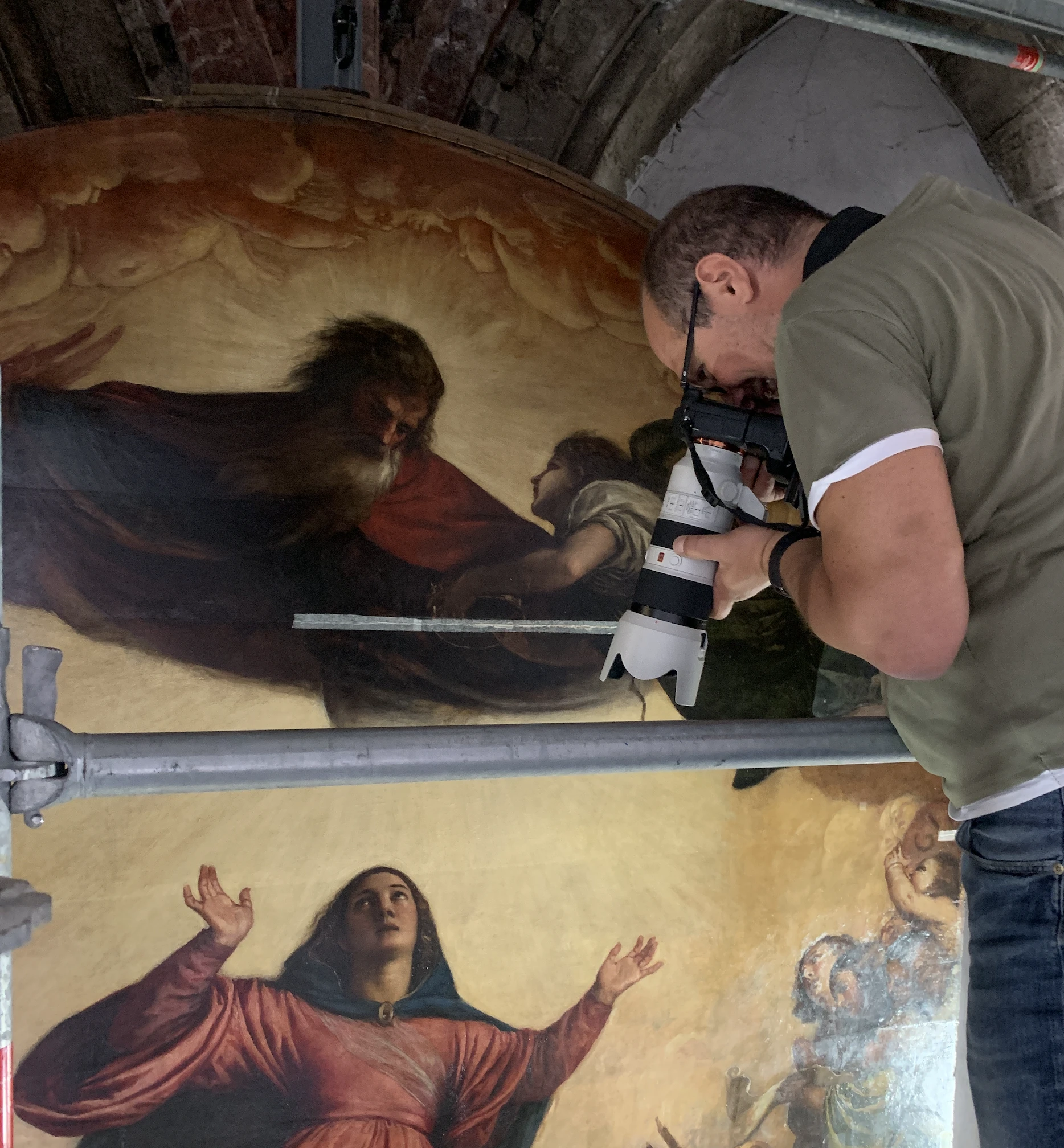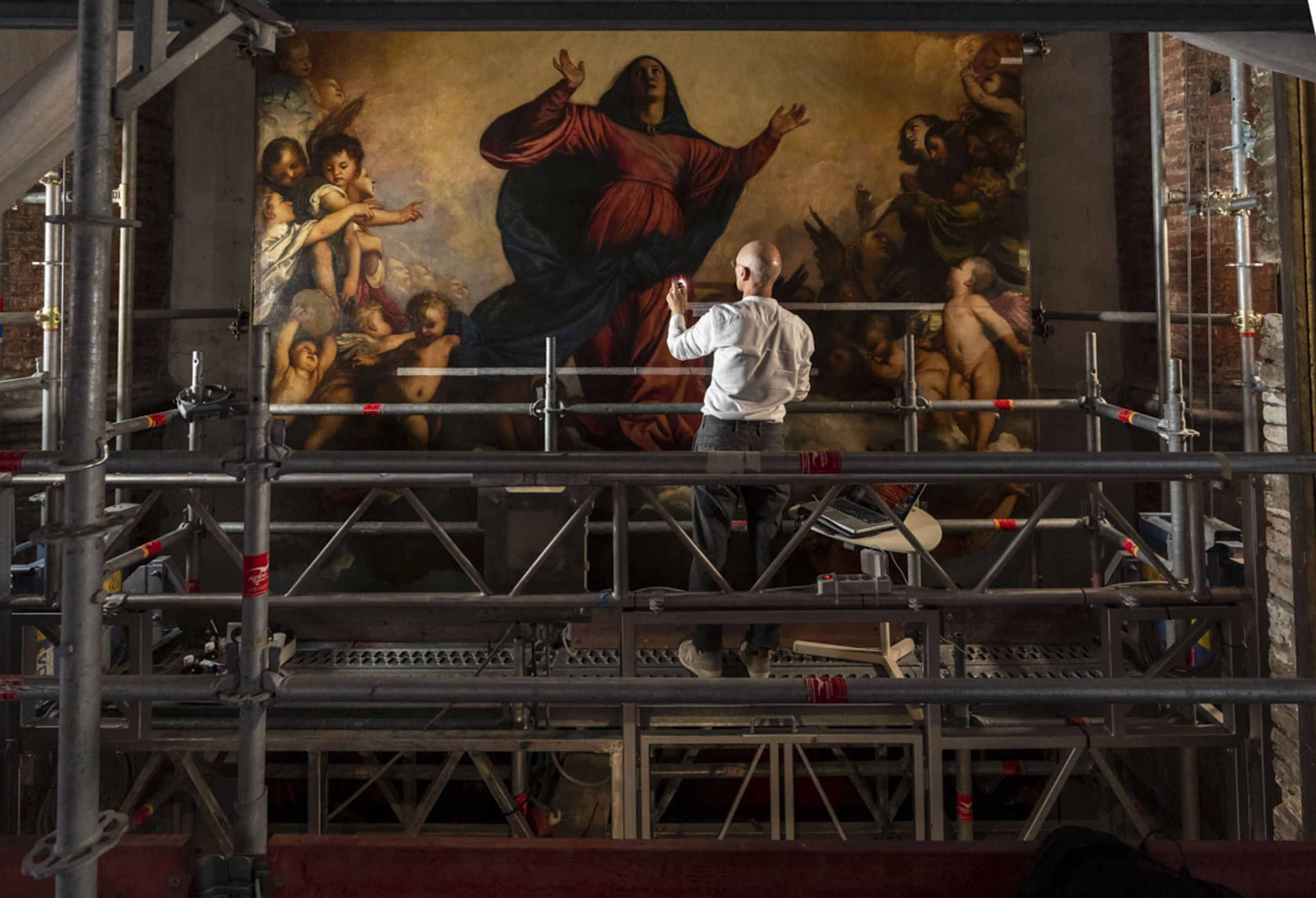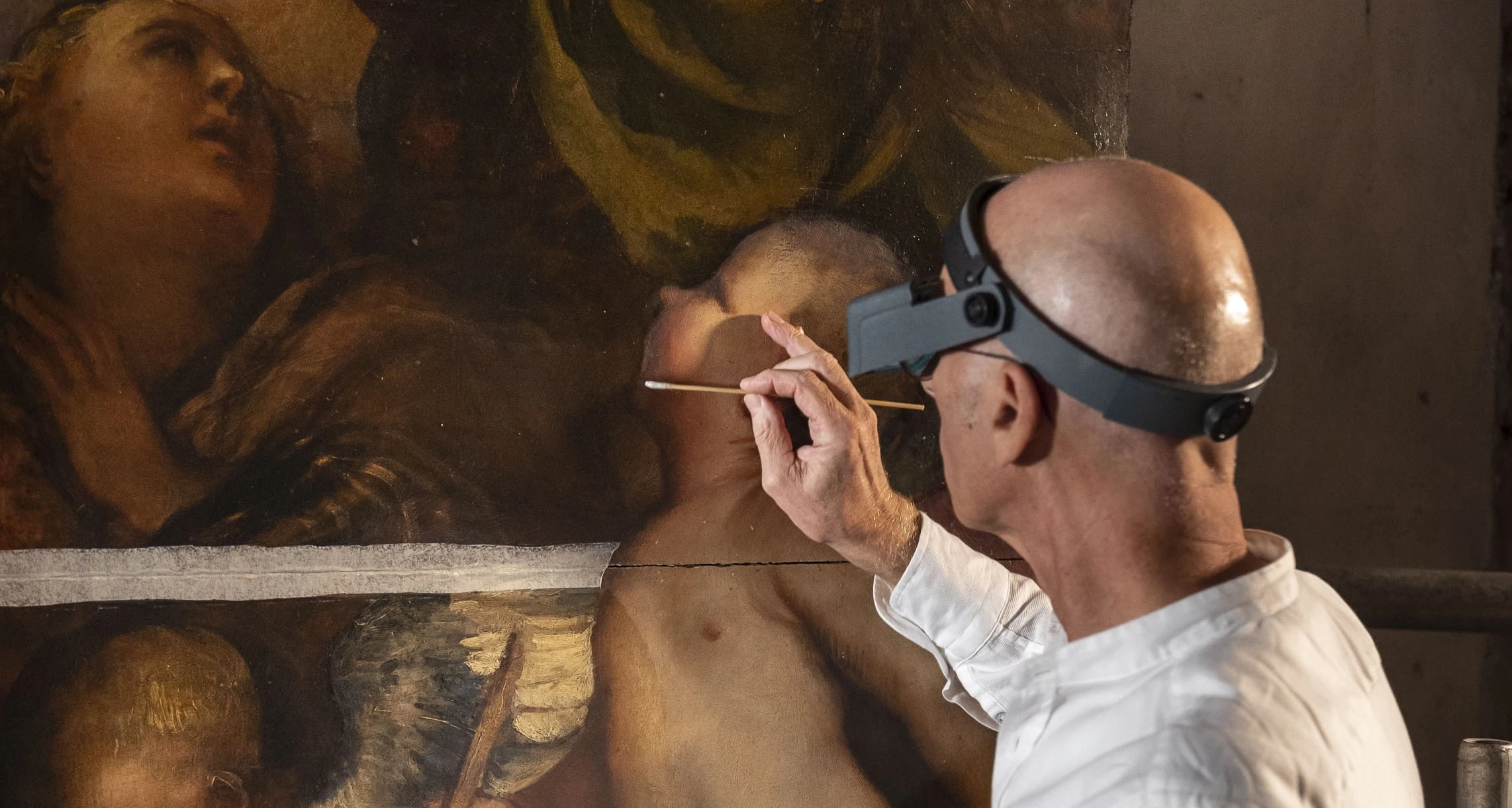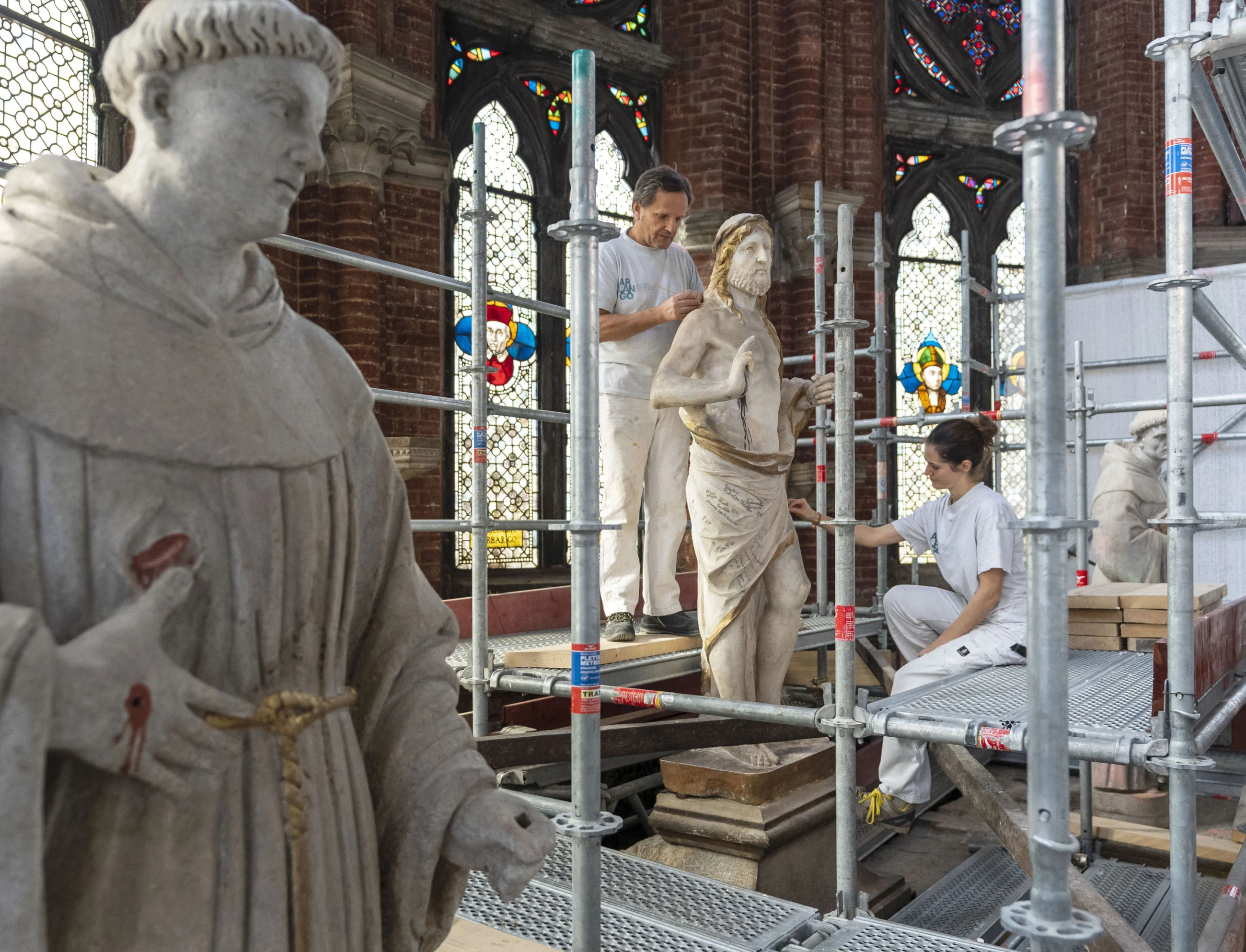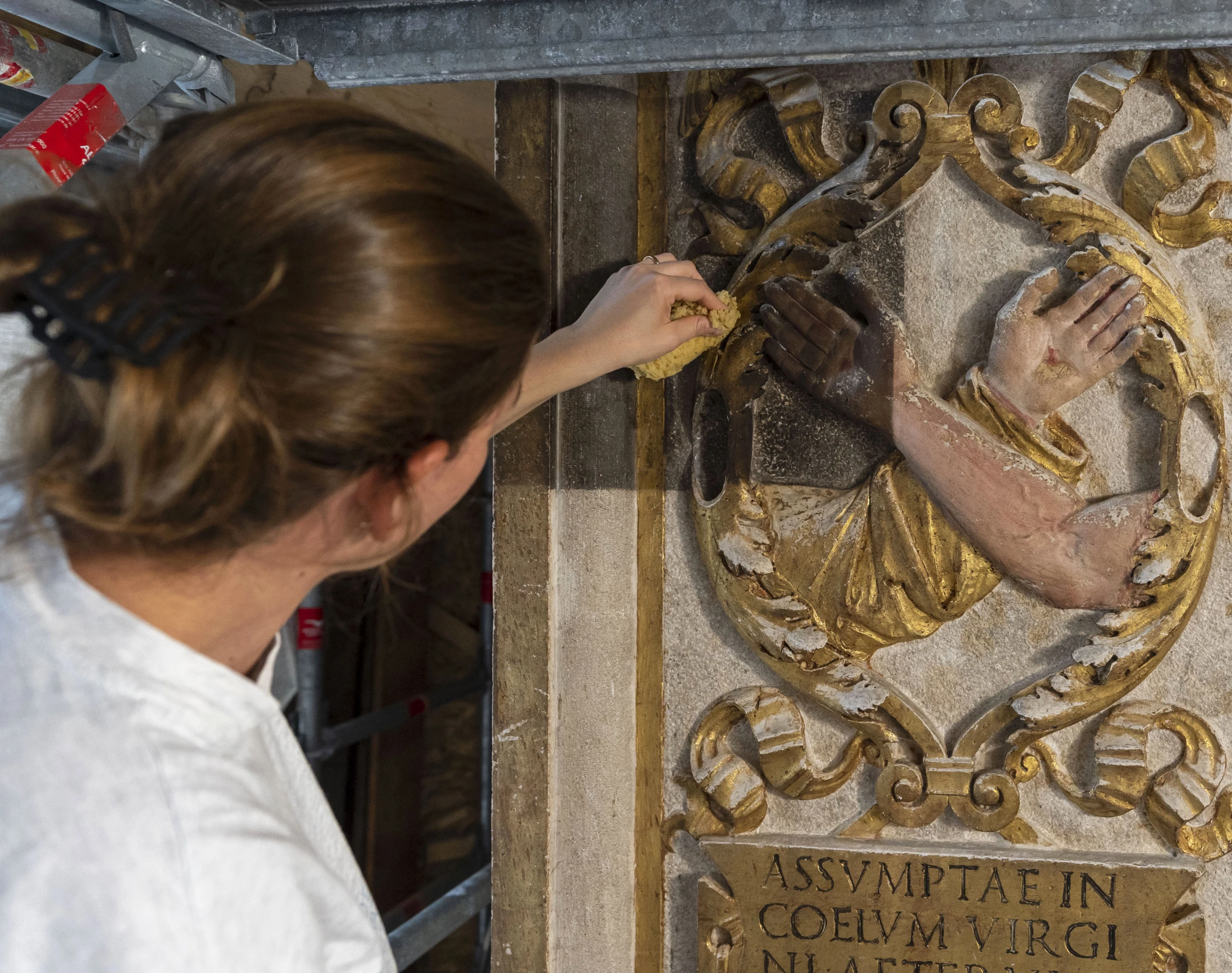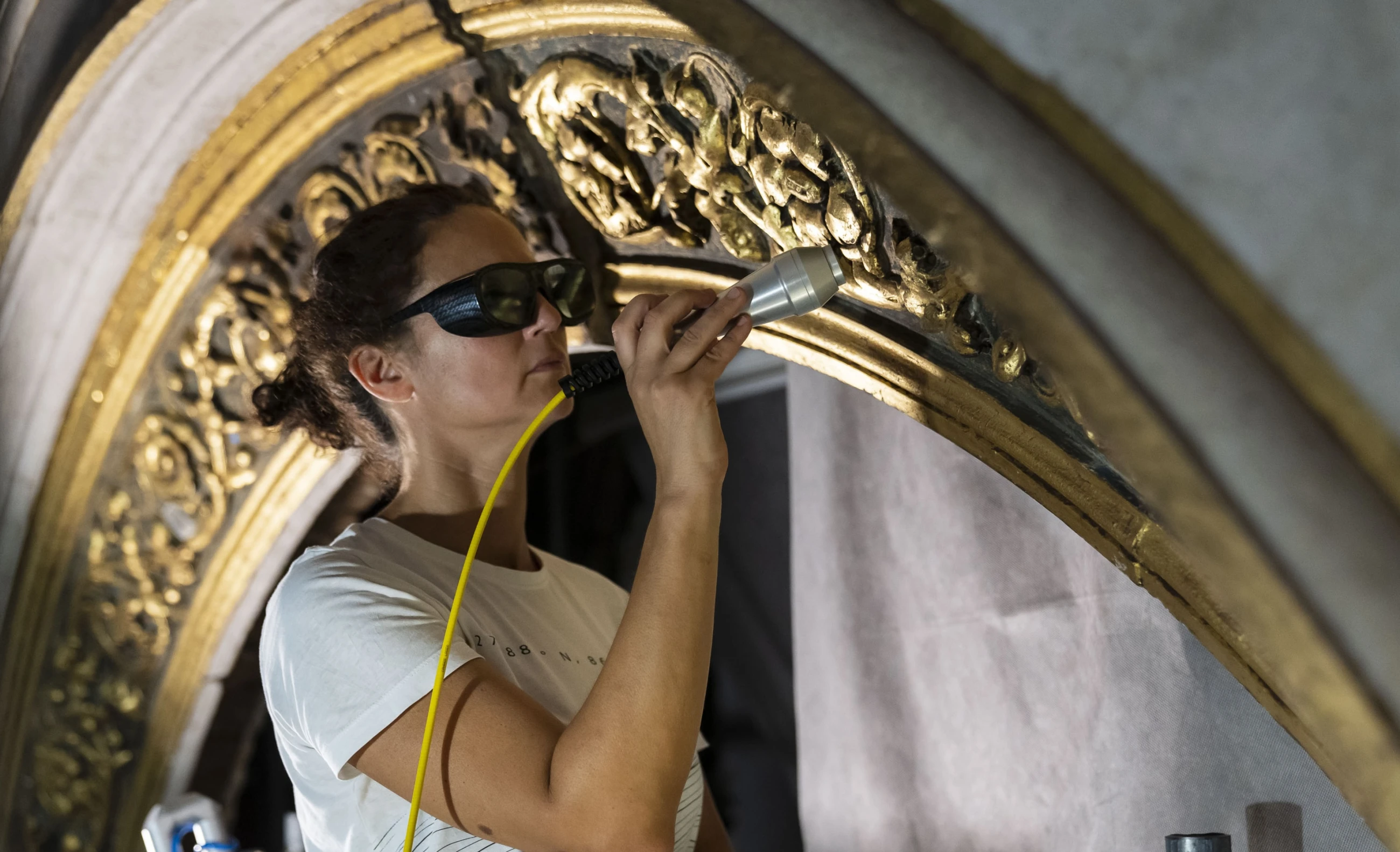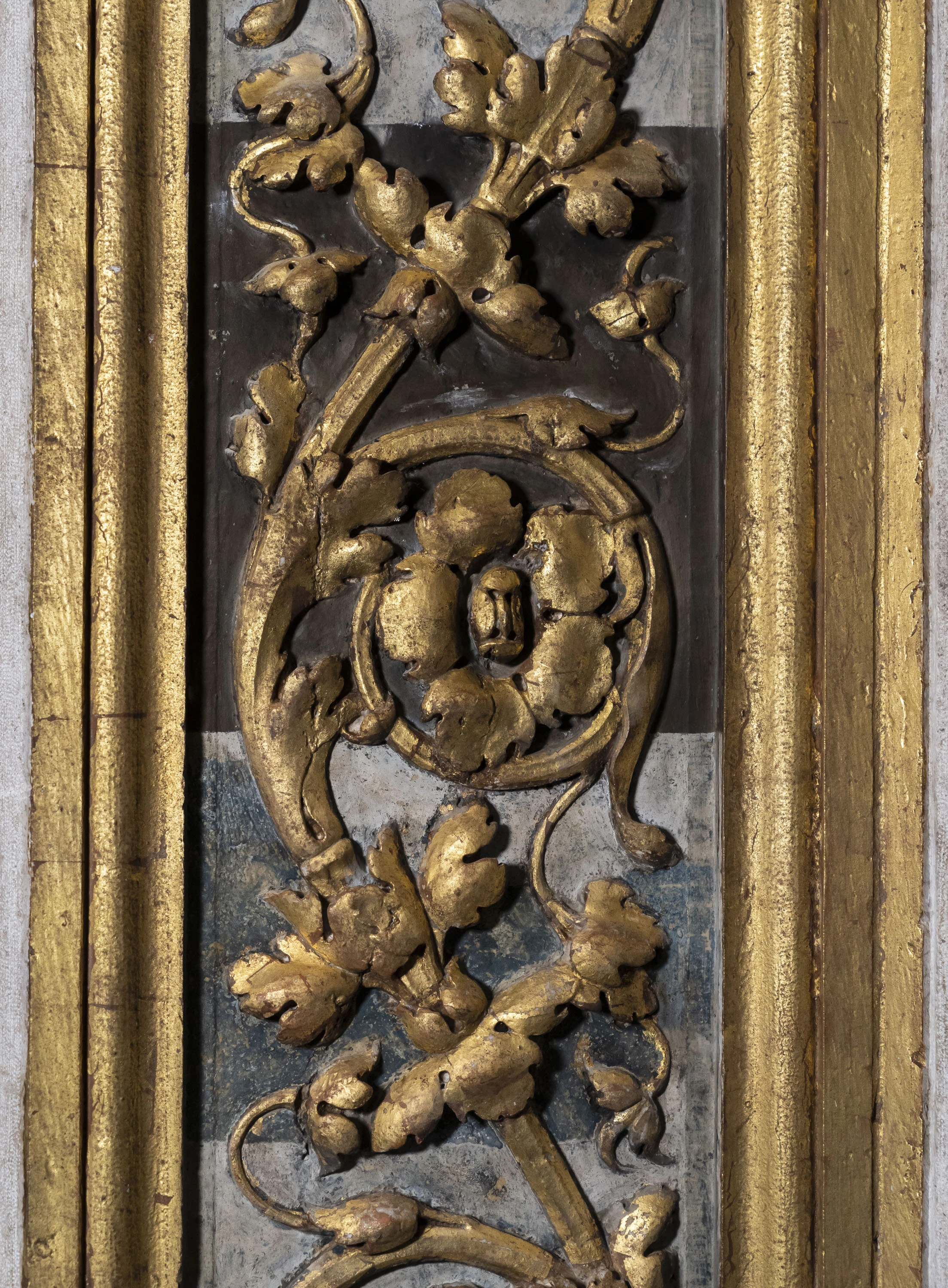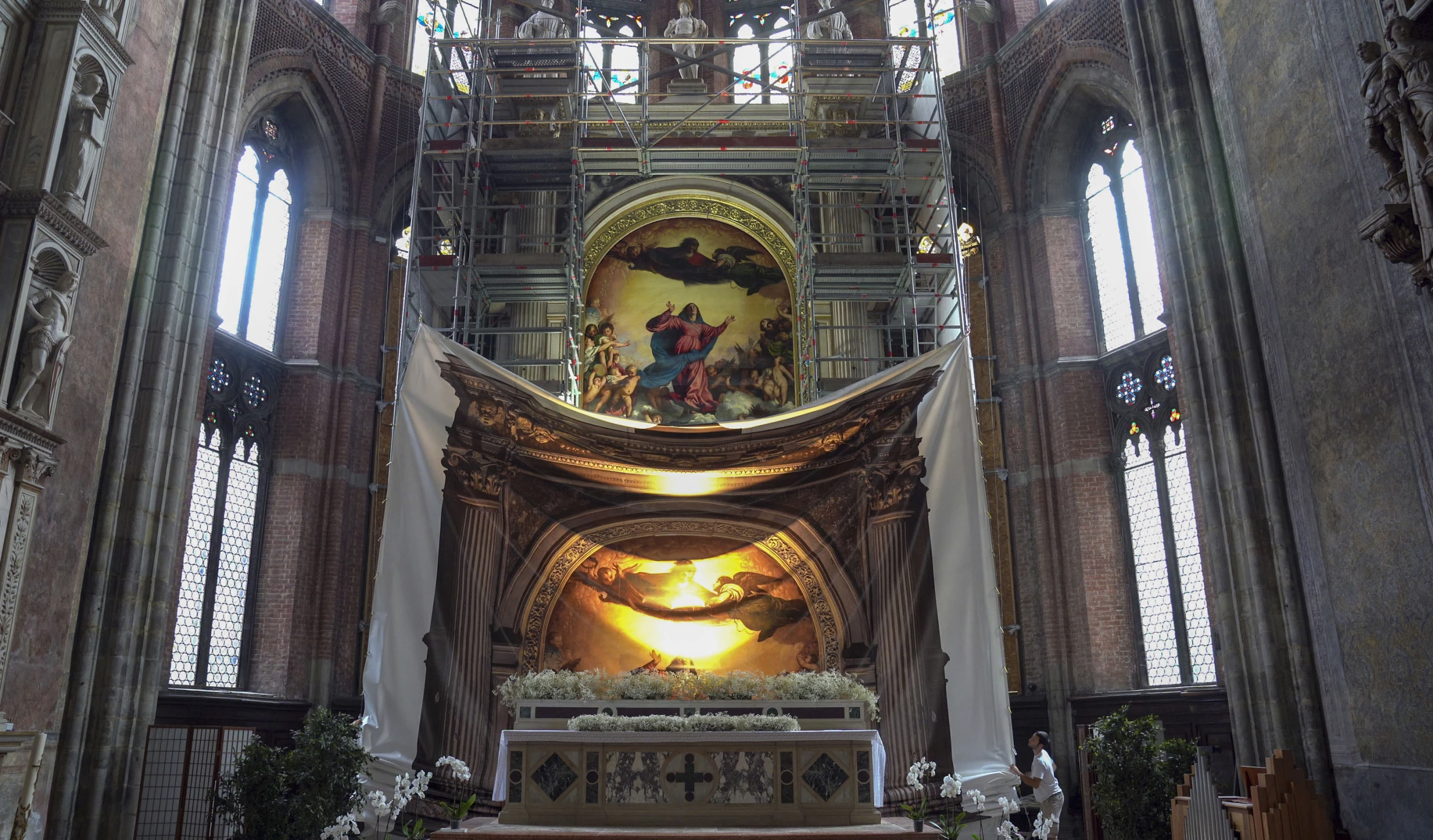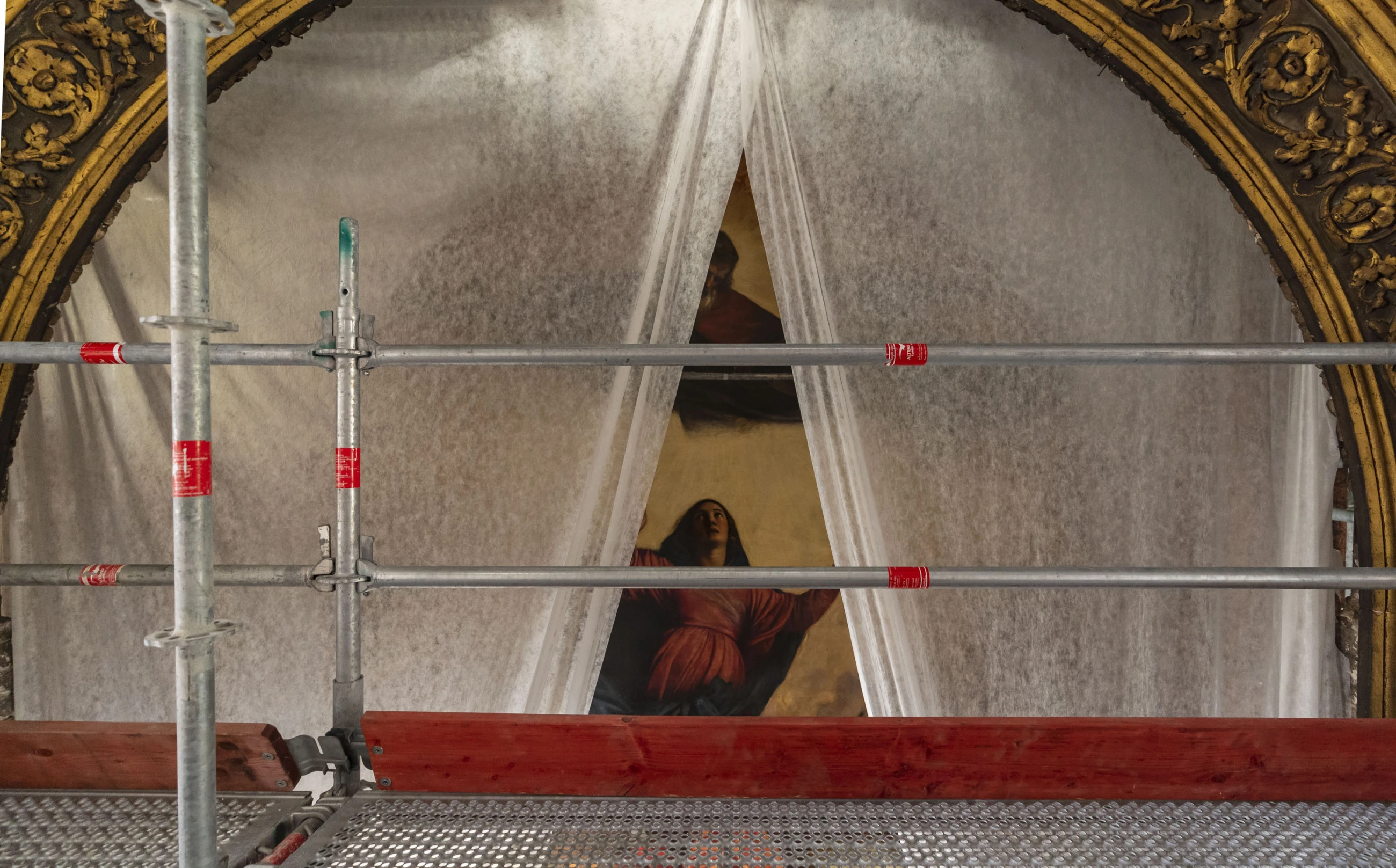
2012 Diagnostic Campaign and Conservative Maintenance
In 2012, Save Venice funded a three-month maintenance treatment to remove surface dust and grim from Titian’s Assunta. This effort was combained with a diagnostic campaign and extensive archival research aimed at reconstructing the conservation history of the painting, whose last restoration occurred in the early 1970s. Conservators identified small areas of lifting and flaking paint on the surface, along with several non-original surface layers, including discolored varnishes from previous restorations.
The condition of the back of the panel and its wooden support was a major concern for conservators. Due to the presence of organ pipes installed directly behind the Assunta in recent decades, they were unable to fully inspect the reverse side of the painting. However, they noted that the wooden components of the organ, located in dangerous proximity of the artwork, were infested with wood-boring insects, posing an immediate threat should the infestation spread. Furthermore, conservators observed that the altarpiece consistently vibrated when the organ was played. Vibrometric tests confirmed that certain areas of the painting experienced significant vibrations, exacerbating the risk of damage to already fragile portion of the artwork.
In light of these findings, the Italian Ministry of Culture authorized the removal of the modern organ in 2018. The organ pipes and keyboard were subsequently donated to a church in Jesolo in the province of Venice, thus ensuring the preservation of the Assunta.
The diagnostic campaign also examined the monumental Istrian stone frame which surrounds the painting, revealing that thick layers of grime were obscuring the white color of the stone itself but also its original gilding and polychrome decoration.
2012 conservative maintenance and analysis campaign made possible with funding from Richard and Carole Rifkind through the Norman and Rosita Winston Foundation.
2018–2022 Conservation Campaign
First of all, three sophisticated and innovative scaffolds were designed on purpose in order to facilitate the conservation process. The first structure, designed by Roberto Saccuman and expertly implemented by the team of the UNISVE firm, was installed behind the altar. This setup allowed the altarpiece to be carefully shifted back onto a platform positioned behind its stone frame, enabling in situ restoration. A second mobile scaffolding, resembling a “window-washer” platform, was employed by conservators Giulio Bono and his team in order to access the painting at heights of up to nearly seven meters. Meanwhile, an additional scaffold was erected in front of and above the altar, allowing Egidio Arlango and his team to restore the marble altar and the statues crowning it. To preserve the visual impact of Titian’s masterpiece throughout the conservation campaign, the scaffolding was draped with a full-scale reproduction of the Assunta, ensuring worshipers and visitors could continue to experience its presence.
The conservation of Titian’s Assunta was meticulously conducted over the course of four years. The painstaking process that Giulio Bono and his team undertook included stabilizing and consolidating areas of lifting paint, carefully cleaning the surface, and removing centuries-old non-original residues that had obscured the vibrant brilliance of Titian’s color palette. The wooden support of the painting was conserved by Roberto Saccuman, who ensured the structural integrity of the panel by reinforcing the most vulnerable areas. Meanwhile, Egidio Arlango and his team focused their expertise on the monumental Istrian stone frame. By meticulously removing layers of dirt and grime, they revealed the frame’s luminous white stone, ornate gilding, and vibrant polychrome details.
On October 4, 2022, the fully restored painting and frame were unveiled to the public. In recognition of his extraordinary skill and dedication, Bono was honored with the prestigious Marino Grimani Prize for excellence in art conservation in the autumn of 2022, cementing his role in safeguarding one of the most celebrated masterpieces of the European Renaissance.
2018-2022 conservation made possible with major funding from Beatrice de Santo Domingo and the Jasmine Charity Trust in honor of Regina Jaglom Wachter.
2018–2022 Conservation Campaign Participants
Owner | Basilica di Santa Maria Gloriosa dei Frari
Funder | Save Venice Inc. with the generous support of Beatrice de Santo Domingo and the Jasmine Charity Trust, in honor of Regina Jaglom Wachter.
Italian Ministry of Culture Oversight | Soprintendenza Archeologia Belle Arti e Paesaggio per il Comune di Venezia e Laguna - Superintendent Emanuela Carpani, Cristina Dossi†, Lucia Bassotto
Curia Patriarcale di Venezia–Office of Beni Culturali Ecclesiastici ed Edilizia di Culto Oversight | Don Gianmatteo Caputo
Project Direction–Painting | Giulio Manieri Elia
Project Direction–Stone Frame | Studio Ingegneri Associati Marzi Paolo Giorgio Todeschini - Mattia Marzi
Worksite Safety Coordination | Studio Ingegneri Associati Marzi Paolo Giorgio Todeschini - Paolo Marzi, Mattia Marzi
Restoration of Titian’s Assunta | Giulio Bono with Silvia Bonifacio, Barbara Bragato, Thomas Charles Nelson, Silvia Ottolini, Giulia Simbula
Restoration of Stone Frame | Egidio Arlango with Elisabetta Pinton, Jasmine Segalin Chiara Da Vià, Alessandra Costa
Restoration of Wooden Support and Movement | Roberto Saccuman with Giovanni Gualdani, Sabrina Montosi, Sandro Galati
Movement Assistance and Logistics | Uni.S.Ve.
Photographic Documentation and UV Investigations | Matteo De Fina
Microclimatic Investigations | Laboratorio Scientifico della Misericordia
Stratigraphic Pigment Analysis, XRF Investigations, and FT-IR Analysis | Stefano Volpin, Lucia Giorgi, Laboratorio Scientifico della Misericordia
Gas Chromatography and Mass Spectrometry Investigations | Antonella Casoli, Università di Parma; Francesca Izzo - Università Ca’ Foscari
X-Ray Investigations | Davide Bussolari - Indagini per l’arte Fabbri
IR Osiris Investigations | Serena Bidorini, Silvia Salvini - Laboratorio scientifico della Misericordia; Claudia Daffara - Opdatech, Università di Verona
Conservation Chemist Consultant | Paolo Cremonesi
Mascioni Organ Disassembly and Conservation | Zanin
Scaffolding | Edilnoleggi Valente
International Consultation Committee | David Alan Brown, Miguel Falomir Faus, Gabriele Finaldi, Paul Joannides, Salvatore Settis, Cleo Malca Nisse (Secretary)
